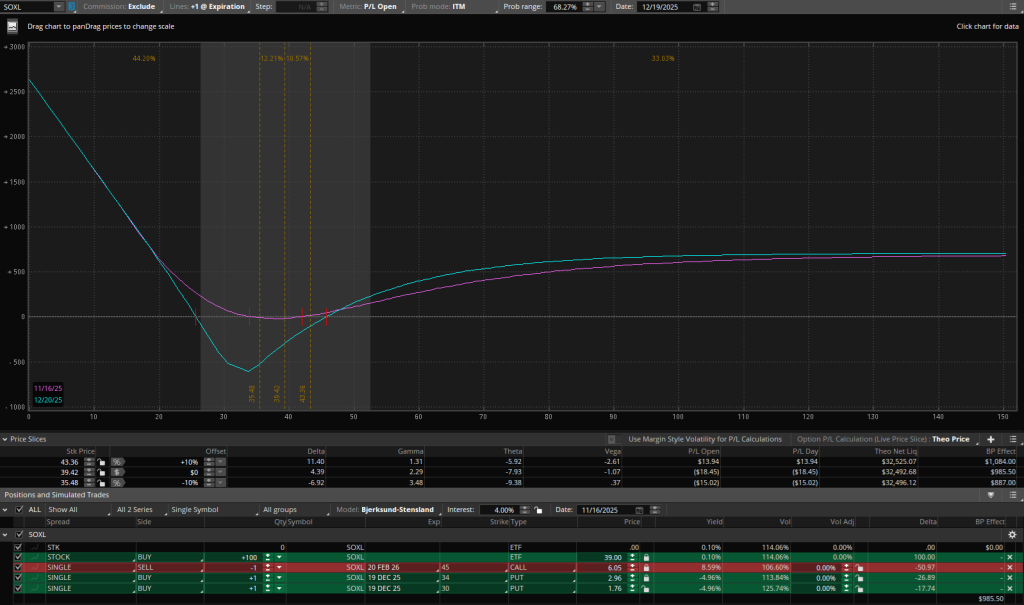Hello again everyone, I hope your Sunday has been peaceful and you’re finding true rest in Jesus. The markets have been crazy these past few weeks but with Him the storms of life don’t have to be a way of life. I believe today if we give our all to Him, He will do the same for us!
Now, I want to introduce everyone to a strategy I’ve been tinkering with these past few days. A ratio collar strategy, specifically a ratio collar strategy on volatile assets. Lately, I’ve enjoyed writing cash secured puts on leveraged ETF’s such as SOXL or TSLL but with the constant change in sentiment I’m getting a little apprehensive. One day we’re wildly bullish, the next, get out while you can!
In that market climate holding short puts is dangerous, at least without a plan. So, I’ve been considering my options for how I’d address assignment of a falling leveraged ETF. Thus, in today’s post I want to discuss the ratio collar strategy on volatile assets.
- My preferred leveraged ETF’s – Top 5 Leveraged ETF’s for Options Trading
- Collar Options Strategy Alternatives – Collar Options Strategy – 3 Ways to Play
- Collar Discussion at Reddit.com – Anyone Like Collars?

Ratio Collar Options Strategy on Volatile Assets
The first question you’re probably asking is why only on volatile assets? Well, that’s simple, the premiums available when selling cash secured puts is far more attractive than safer assets. So, really what I’m suggesting today is a strategy that avoids calamity if a cash secured put gets assigned.
Personally, I don’t want to hold leveraged ETF shares. Some may but it’s just not where I want to park my limited capital. I realize there is an equal chance these leverage ETF’s outperform but that knife cuts both ways, as we well know. So, I needed to come up with a strategy to protect myself if I did get assigned on a cash secured put that was past the point of rolling.
What I’ve come up with is a ratio collar strategy that can be initiated once shares are assigned. Much like the traditional collar strategy I give up upside appreciation in return for downside protection. However, depending on the construction and the amount of risk I’m comfortable with it could yield terrific results. At the very least, it will avoid a disastrous loss.
Ratio Collar Strategy

Here is an image of what I’ve been considering. As you can see from the image, I’m long 100 shares, short the $45 strike call, and long two different puts. This more than negates disastrous downside but again, at the expense of upside appreciation. This I accept. However, what I’m troubled with is whether I should have at least one long put expiring further out in time.
From the image above, this may be the preferred construction if downside was an immediate concern. Which likely it would be if a far out of the money put were to be assigned. Though, given the nature of leveraged ETF’s I’m not sure I’d experience much theta gain from the short call if price didn’t move. Thus, I’ve been tinkering with how I may set this up should the need arise.
Again, I don’t want to mislead anyone, I’m not suggesting this be an option strategy unto itself. It certainly could be but I don’t see much value in that alone. The primary reason for the ratio collar strategy on volatile assets is for downside protection if the market gets crazy. This strategy does that while also leaving the door open for some level of profit.
Final Thoughts
I haven’t quite decided yet how I’d structure this if a short put is eventually assigned. Truthfully, I hope I have plenty of time to consider it further. But, in the off chance I am assigned soon, this at least gives me a tool I could use other than just sitting around and waiting.
In all, the ratio collar strategy is an aggressive approach to downside protection on a potentially volatile underlying. The additional long put option creates a payoff diagram that allows for uncapped downside profit without completely eliminating upside potential. The short call is there to pay for the puts and possibly provide a small income should price stagnate.
Lastly, you may have noticed from the image above that vega is negative. This is another area I’m not quite sure about at this moment. I think I like the negative vega profile given that a large market drop would probably come with higher volatility. Should the market fall, volatility rise, and I get assigned shares the more probable outcome would be that volatility subsides. Though, when the market is declining rapidly I really prefer to be long vega. To do that here, I’d have to buy yet another put or avoid the short call all together.
I guess we’ll see in time how it works out. What do you think? Have a better idea on how to protect the downside on these leveraged ETF’s? Let us all know in the comments below.
Until the next post.
God bless,
Jeff









